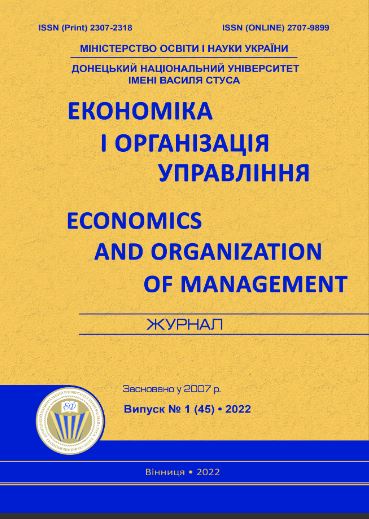Concepts of circular business models of key european companies
DOI:
https://doi.org/10.31558/2307-2318.2022.1.3Keywords:
circular economy; waste; circular business model; recyclingAbstract
The circular economy is designed as a continuous positive cycle of development that protects and increases natural capital, optimizes the return on resources and minimizes systemic risk through the management of final stocks and recovery flows. The circular economy retains resources in the material cycle and reduces waste generation by reducing resource consumption, more thoughtful design, and risk prevention. The authors of the article consider the essence, structure, and concepts of circular business models of leading companies in the European Union. The peculiarities of the impact of zero-waste production on the economy by reducing costs, increasing competitiveness, creating new jobs are presented. Practical importance is that the results of the study can serve as a basis for recommendations for the introduction of a circular economy through the development of modern circular business models in Ukraine, the described business models of European countries can be used by entrepreneurs in the domestic economy.
References
Rizos V., Tuokko K., Behrens A. The Circular Economy A review of definitions, processes and impacts. Energy Climate House. 2017. 36 p.
Braungart M., McDonough W. Cradle to cradle: Remaking the way we make things. North Point Press. 2002. 208 p.
Weetman C. A circular economy handbook for business and supply chain. Repair, Remake, Redesign, Rethink. Kogan Page. 425 p.
Hawken P., Lovins L. H. Natural Capitalism: Creating the Next Industrial Revolution. Little, Brown & Company. USA, 1999. 396 p.
Pauli G. The Blue Economy: 10 years – 100 innovations – 100 million jobs. Paradigm Publications. 2010. 386 p. URL: http://www.yooyahcloud.com/MOSSCOMMUNICATIONS/gpwPMb/Blue_Paper_1_Opport unities_of_the_Blue_Economy.pdf (дата звернення: 03.10.2021)
Porring J. Circular economy: measuring innovation in the product chain. Netherlands Environmental Assessment Agency. 2017. 46 p. URL: https://www.pbl.nl/sites/default/files/downloads/pbl-2016-circular-economy-measuring-innovation-in-product-chains-2544.pdf (дата звернення: 06.10.2021)
Гахович Н. Г., Кушніренко О. М., Зарудна О. С. Циркулярна економіка як стратегічний пріоритет розвитку глобальних ланцюгів доданої вартості. Економічний вісник університету. Хмельницький, 2020. Вип. № 46. С.103-115.
Галак І.І. Замкнений ланцюг постачань: інструмент забезпечення сталого розвитку сучасного підприємства. Підприємництво в аграрній сфері: глобальні виклики та ефективний менеджмент в рамках 20-ої агропромислової спеціалізованої виставки «АгроТехСервіс – 2021» Запорізької торгово-промислової палати. Запоріжжя, 2021. С.166-169.
Мішенин Є.В, Коблянська І.І. Перспективи і механізми розвитку циркулярної економіки в глобальному середовищі. Маркетинг і менеджмент інновацій. 2017. №2. С.339-343.
Набока Р.Ю. Механізми трансформації державного регулювання циркулярної економіки в Україні. Державне управління: Вдосконалення і розвиток. Харків, 2021. №7. DOI: 10.32702/2307–2156–2021.7.71
Antikainen M., Valkokari K. A Framework for Sustainable Circular Business Model Innovation. Technology Innovation Management Review. 2016. Vol .6. P. 5-12. DOI:10.22215/timreview/1000
Валько Д.В. Циркулярна економіка: основні бізнес-моделі та економічні можливості. Журнал экономической теории. 2020. Т. 17. № 1. С. 156–163.
Towards the Circular Economy: Accelerating the scale-up across global supply chains. Ellen MacArthur Foundation and McKinsey & Company. World Economic Forum. 2014. URL: https://www3.weforum.org/docs/WEF_ENV_TowardsCircularEconomy_Report_2014.pdf (дата звернення: 15.10.2021)
Gillabe J., Manshoven S.. Business Models in a Circular Economy. European Topic Centre Waste and Materials in a Green Economy. 2021. 67 p.
Circular Advantage: Innovative Business Models and Technologies to Create Value in a World without Limits to Growth. Accenture. 2014. URL: https://www.accenture.com/t20150523T053139__w__/usen/_acnmedia/Accenture/Conversio n-Assets/DotCom/Documents/Global/PDF/Strategy_6/Accenture-Circular-AdvantageInnovative-Business-Models-Technologies-Value-Growth.pdf (дата звернення: 16.10.2021)
Hauser, W. Remanufacturing:An American Resource. Boston University. DOI:10.1049/cp.2010.0404
Remanufacturing Market Study. Report of EC. 2015. 145 p. URL: https://www.remanufacturing.eu/assets/pdfs/remanufacturing-market-study.pdf (дата звернення: 16.10.2021)
Business Models in a Circular Economy. European Topic Centre Waste and Materials in a Green Economy. URL: file:///C:/Users/denis/Downloads/2.1.2.4.%20ETC%20Eionet%20Report%20Circular%20Bus iness%20Models_final_edited%20for%20website%20(4).pdf (дата звернення: 22.10.2021)
Europe’s first circular economy factory for vehicles: Renault. URL: https://ellenmacarthurfoundation.org/circular-examples/groupe-renault (дата звернення: 22.10.2021)
Universal registration document including the Annual financial report 2020 of Groupe Renault. URL: https://www.renaultgroup.com/wp-content/uploads/2021/04/renault-deu-2020- accessible-version.pdf (дата звернення: 22.10.2021)
IKEA Sustainability Report FY20. URL: https://about.ikea.com/- /media/aboutikea/newsroom/documents/578053_v2.pdf?rev=d84a69bac42f4284a9e414db9e5 4e683 (дата звернення: 23.10.2021)
Руда М. В., Мирка Я. В. Циркулярні бізнес-моделі в Україні. Національний університет «Львівська політехніка». 2020. Том 2. № 1. С.107-121.
Philips approach to recycling. URL: https://www.philips.com/aw/about/environmental-social-governance/environmental/circular-economy/recycle (дата звернення: 23.10.2021)
Philips Annual Report 2020. Innovating to address global health challenges. URL: file:///C:/Users/denis/Downloads/PhilipsFullAnnualReport2020-English.pdf (дата звернення: 24.10.2021)
Michelin: Recycling end-of-life tires. URL: https://www.michelin.com/en/activities/high-tech-materials/recycling-end-of-life-tires/ (дата звернення: 24.10.2021)
Чуріканова О. Ю. Інноваційні бізнес-моделі циркулярної економіки на регіональному рівні. Вісник Хмельницького національного університету. 2020. № 4. Том 1. С.204-208.
Ковальчук С.Я., Лукіяненко Р.О. Циркулярні бізнес-моделі в агропродовольчій сфері. Економіка природокористування та охорони навколишнього середовища. 2020. Вип. 29. С.284-290.
Resale Report of ThredUP. 2021. URL: https://www.thredup.com/resale/#resaleindustry (дата звернення: 24.10.2021)
Кузьменко Ю.М. Вплив циркулярної економіки на формування бізнессередовища розвинутих країн світу. Національний університет «Запорізька політехніка». Запоріжжя, 2020. 141 с.
A New Textiles Economy: Redesigning Fashion’s Future. URL: file:///C:/Users/denis/Downloads/A%20New%20Textiles%20Economy%20- %20Full%20Report%20-%20Updated%201-12-17.pdf (дата звернення: 25.10.2021)
The trends and trailblazers creating a circular economy for fashion. Ellen MacArthur Foundation. URL: https://ellenmacarthurfoundation.org/articles/the-trends-and-trailblazerscreating-a-circular-economy-for-fashion (дата звернення: 25.10.2021)
Mostaghela R., Chirumalla K. Role of customers in circular business models. Journal of Business Research. 2021. Vol. 127. C.35-44
Rodenbach J., Mathis J. Car sharing in Europe. URL: http://stars-h2020.eu/wpcontent/uploads/2018/10/Abstract-D-2.1.pdf (дата звернення: 25.10.2021)
Number of members enrolled in European car-sharing programs in selected years from 2006 to 2018. URL: https://www.statista.com/statistics/1190247/car-sharing-car-sharingmembers-in-europe/ (дата звернення: 27.10.2021)

